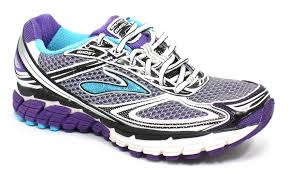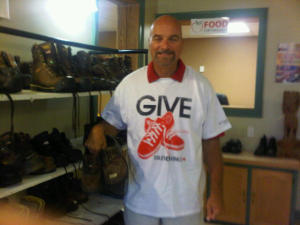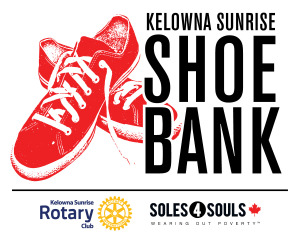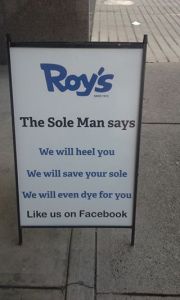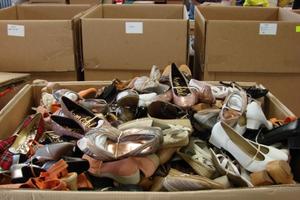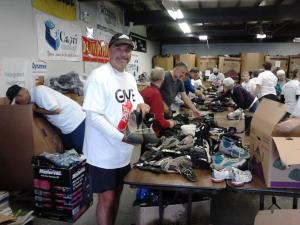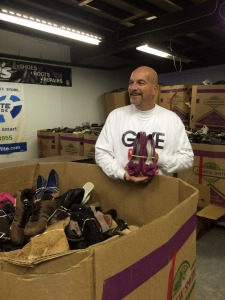An American in Kelowna – Boots on the Ground at the Kelowna Sunrise Rotary Shoe Bank
One my first morning volunteering at the Kelowna Shoe Bank, I took this request from a dubious customer: “I need a pair of runners, size 10. Do you have those?”
“Gee, sir, I’m not sure?” was my rookie retort. “Let’s go back to the main showroom and check out our inventory.” Before leading him into the shoe room, I had to pull shoe maven (and boss lady) Donna Moyer aside and ask her “what runners were?”
She laughed and said “tennis shoes.”
There I was. Learning on the job. Getting my feet wet. Being a sole man. Heel-bent on customer service. Boning up on Canadian street talk. It was late August and scorching-hot outside. The Shoe Bank office on 1264 Ellis Street had only been open for business for a couple weeks. Hours were limited: Mondays and Thursdays from 9:30 a.m. to 1:00 p.m.
Turns out the organization’s official name is the Kelowna Sunrise Rotary Shoe Bank. It’s one leg of a partnership between the Kelowna Community Food Bank and Soles4Souls Canada. No loafers in this group of givers.
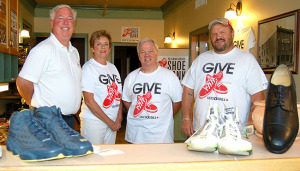
The organization has a targeted tagline – Wearing Out Poverty.
Jim Belshaw, chair of Soles4Souls Canada and owner of Roy’s Shoes Boots and Repair in downtown Kelowna, is the visionary driving his shoe business to loftier heights. His team of organizers and volunteers has handled a significant increase in shipping crates of footwear across Canada and to impoverished countries such as Cuba, Haiti, Honduras, and Jamaica. Have wing tips – will travel. Need a boatload of flip flops and sandals for warmer climes – no worries, eh?!
The inventory of gently used (and some almost brand new from the manufacturer) shoes is impressive and growing exponentially. But, like Jello, there’s always room for more. Much more. Men, women, and children in need can be fitted with footwear in all kinds of styles, sizes, shapes, and colors. In particular demand are steel-toed boots oil-field workers, interview-quality dress shoes for job seekers, and water-proof snow stompers for winter. Less in demand are fuzzy bunny slippers and six-inch stiletto heels.
Come and get’em. The price is right.
So far I’ve shoe-horned myself into three “shoe sortings” at the Shoe Bank warehouse. At these morning sessions, a gaggle of do-gooders sift through bags and bags of donated carpet huggers. Pairs need to be matched up and bound together before being sorted and deposited into extra-large cardboard bin for storing and/or shipping. Laces and soles from unusable items are often stripped and recycled. Gotta admire the no-usable-part-left-behind efficiency.
My goal is to lace’em up at least once a week at the Shoe Bank. I’ve been welcomed, shown the ropes, and turned loose for toe-to-toe sizings and fittings with Kelowna’s less fortunate. It’s a not-for-profit organization that fits into “permissible” charity work per my status with Citizenship and Immigration Canada (CIC). And, better yet, it’s been a valuable networking experience. There are many benefits to putting one’s best foot forward and helping others.
Most feet have Five Little Piggies. Let’s Squeeze into Five questions for shoe maven Donna Moyer:
1. How does a person or family qualify and become eligible to utilize the services of the Shoe Bank (explain the necessary steps)?
The client uses the services of the Food Bank or other social agencies. They are given a ‘voucher’ stating the number of pairs of shoes they require. We are able to help them with shoes to use for work or just to be able to have something warm on their feet.
2. How often can this same person/family come back for another pair of shoes, and why?
We have put in place a return every 3 months. Due to the fact that we may be getting snow soon we have reduced that wait time, depending on what is chosen, in order for men, women and children to find winter gear.
3. Where is the Shoe Bank getting its shoes from – individual donations, shoe manufacturers and wholesalers, shoe companies, all of the above (explain)?
We mainly receive our footwear from individuals as they clean out their closets. We have had the wonderful opportunity of receiving shoes, as well, from shoe manufacturers, such as Keen, and companies like Mark’s Work Wearhouse. We’ve also received runners from the sporting event called “Tough Mudder.” The majority come from the general public.
4. Can you share with us some of your success stories in shipping shoes to overseas destinations, and secondly, how are shipping costs covered?
Since we started we have always opened the doors to all the social agencies in the Okanagan before any footwear went anywhere. At that time, our unofficial name was the Shoe Box Project and we worked out of donated warehouse space where shoes were sorted. This was only once a year initially during the big shoe drives in the spring. It became quickly apparent that more was needed on a year-round basis. In the first years I’d say 3,000 to 4,000 pairs of shoes made it out into our community. The remaining items were shipped to the U.S. for distribution to one of 125 different countries that S4S USA works with. This year, with the donated space from the Kelowna Food Bank, we were able to open year round. To date, we have helped 600 households/families and over 1,000 pairs have found their way to the feet of locals in last few months.
These last couple of years from Kelowna we have had local residents take and distribute footwear to Cuba, Haiti, Mexico, Jamaica, El Salvador, and Honduras. The past two years we have shipped the remaining inventory direct to an Enactus Group at the University of Ghana. This outfit used them to run and teach micro businesses to local Africans. The group in Ghana covered the costs. There are many groups like the Enactus group who work in the micro-enterprise world that S4S associates with.
5. How many pairs of shoes would you estimate have already been given out or shipped, and what are the long-term goals of the Shoe Bank heading into 2015 and beyond?
We are approaching 500,000 shoes collected and distributed. Our goal is to collect one million pairs of shoes for each province and territory in Canada (13 million). We hope the Shoe Bank will continue to expand its reach into every corner British Columbia and extend into Alberta within the next two years. I also envision Shoe Banks opening up in many other communities across Canada and being run by volunteers/Rotarians.
